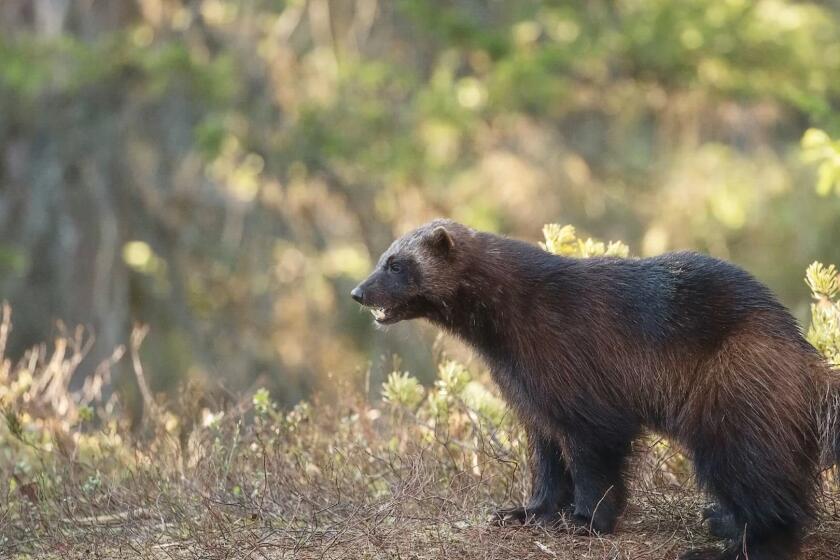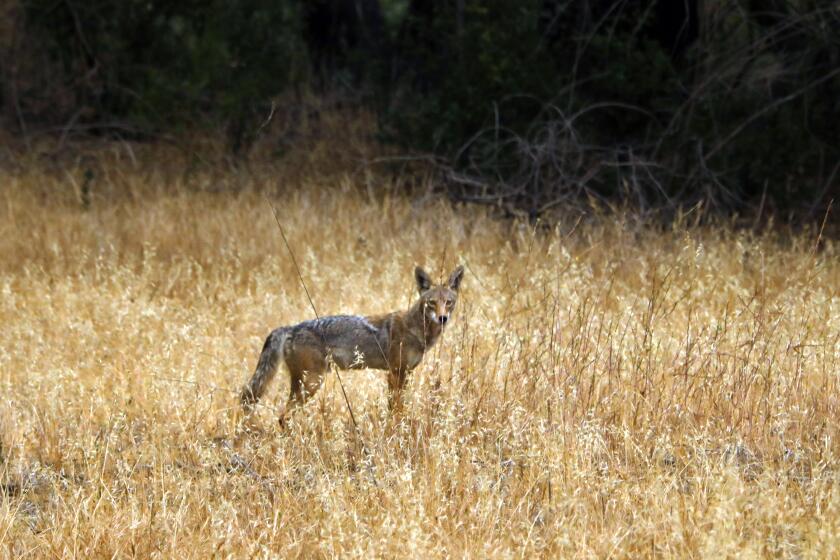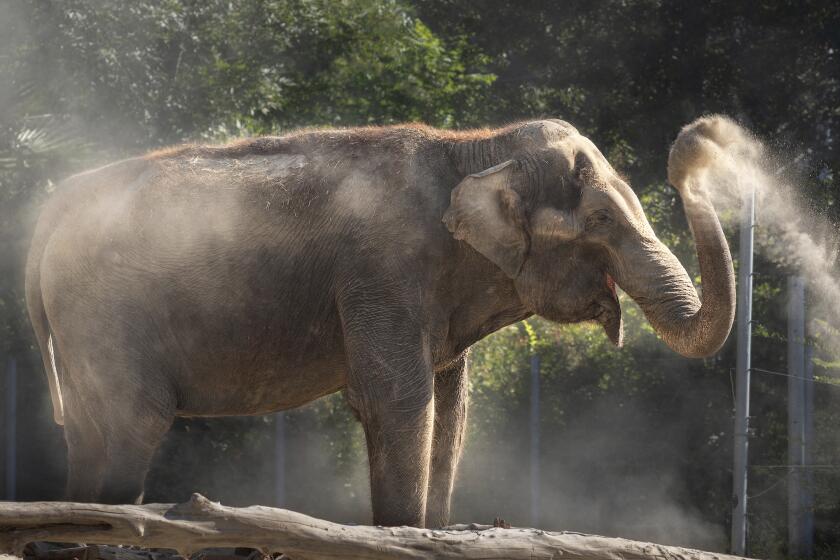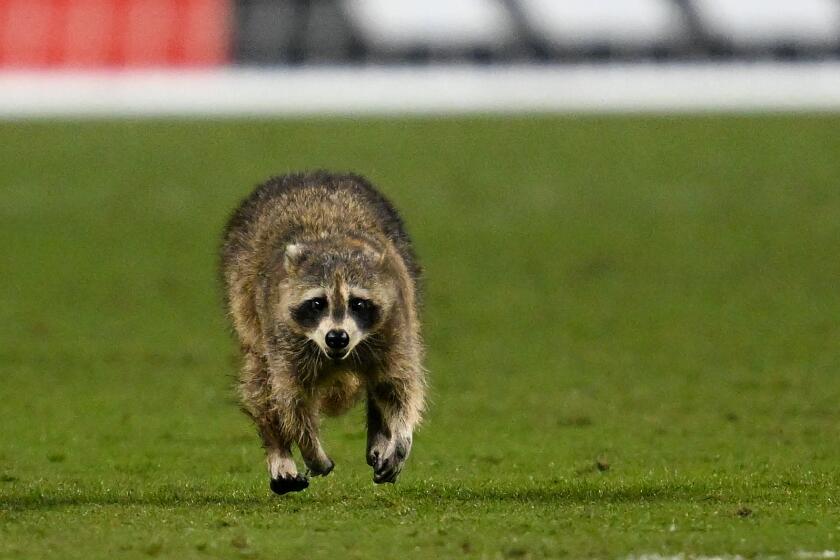Changes in Their Native Habitat Could Be a Boon for the Cats, Authorities Report
The tiny sprouts peeping up from the charred chaparral in east Ventura County last fall looked innocent enough.
*
But authorities now say these survivors of the Green Meadow fire might be helping to bring two species at the top of the food chain--mountain lions and humans--into conflict more often.
Once a rarity, sightings of lions on the edge of the human world are on the rise throughout Ventura County.
And they might continue to rise because of the 1993 fire and the two rainy winters before it, wildlife biologists say.
“The population definitely is up,” said Morgan Boucke, a biologist with the state Fish and Game Department.
Because lions need large territories to hunt, a habitat change in one area--such as the wide swath blackened by the fire in the east Santa Monica Mountains--can induce the animals to migrate to new ranges, biologists say.
This could cause a ripple effect in lion communities throughout the eastern county and beyond, particularly after the current litters of cubs come of age.
“It’s too early to tell just how much of an effect this will have,” Boucke said, “because it’s first noticed in the herbivore (prey animal) population.”
“The effect might be a couple of years away,” concurred Paul Edelman, staff ecologist with the Santa Monica Mountains Conservancy.
The big cats, historically limited in number by their food supply, suddenly are enjoying a lion’s share of game, state biologist Chanelle Davis said.
*
Mule deer, their favorite quarry because they are large and require fewer hunts, have multiplied in response to the lush new growth triggered by hot fire and cool rain, Warden John Wilcox of the state Fish and Game Department said.
“Old decadent shrubs are very woody and can’t support as many deer,” plant ecologist Mary Meyer said. “(Deer) really thrive on the fresh re-sprouts.”
In addition to clearing the old growth and the ground litter that inhibits new sprouts, fire also releases such nutrients as potassium and nitrogen that can fertilize the soil, Meyer said. Some plant species even rely on fire for their seeds to germinate.
“We have outstanding deer numbers now,” said Wilcox, who patrols the Santa Monica Mountains.
“We have a high number of lions in the mountains,” he added, “and I feel that’s because there’s plenty of forage for their prey population.”
*
Female lions, healthier because of abundant food, can be more easily impregnated, have larger litters and experience lower mortality rates within them, Boucke said. She said more young cats are subsequently dispatched into already crowded lion territories, which can be 100 square miles or more.
For many lions, typically young males, this competition for ever-shrinking territories is fatal. “Most of the deaths of mountain lions occur because of other mountain lions,” Davis said of the battles for domain. “They’re pretty brutal.”
Wilcox, unable to think of any prime lion habitat locally that is not already occupied--indeed saturated--said some cats are wandering into areas they previously might have avoided.
“Yes, they’re going to disperse farther,” Boucke said. “And that’s how new populations are established.”
This could bring mountain lions closer to human development and to whatever new food source--dogs, cats, livestock--that might stray beyond the street lights and the cul-de-sacs, Wilcox said.
“We unknowingly have created a new food base--dogs that are well-fed, cats that are well-fed, gardens that draw deer,” Boucke said.
Further, because of the ban on lion hunting and the increasing frequency of contacts between lion and man, the behavior of the big cats might be evolving, Boucke said.
“With the pressure of hunting off, they’re losing their fear of humans,” Boucke said. “We’re not a threat anymore. We’re not shooting them. We’re not hunting them with dogs. We may have somewhat created their elusive behavior in the first place.”
*
In Ojai and Moorpark, lions, probably younger ones that are less experienced hunters, have even tried to attack horses in recent years, she added. All attacks failed, as did two in May in Agoura, Wilcox said.
Tim Miller, a ranger with the Santa Monica Mountains Conservancy, said he found what appeared to be the claw marks of a lion on his quarter horse’s rump on May 10. The sorrel mare apparently had been attacked during the night while in its corral in Agoura, about a mile south of the Ventura County line.
“That’s an interesting question, whether there are new niches being created for the young lions, and whether they’re moving into new areas,” ecologist Edelman said.
Canyons, freeways, Wildwood Park in Thousand Oaks, Jordan and Ahmanson ranches in east Ventura County, all can serve as temporary corridors through which lions can leave one territory, typically under the cover of night, and enter another, Boucke said.
Evidence of the cats’ movement, though anecdotal, is indicative of a greater mixing of previously segregated populations, she said. Boucke noted that a lion was recently killed on the Santa Paula Freeway near Fillmore and another on a freeway in Glendale.
Lions also have been seen crossing the Ventura Freeway, on the Conejo Grade east of Camarillo, where they could move from the west Santa Monicas to the ranges to the north, Boucke said.
*
They also have been seen crossing the freeway in the Agoura Hills and Calabasas areas, where cats from the Santa Monicas can move into the Simi Hills of eastern Ventura County, authorities say.
Always mobile creatures, the big cats even have been known to range as far as 400 miles, if necessary, Boucke said.
“Actually the movement is two directional,” Wilcox said. “It’s an outward push for the cats . . . and an inward push from human development. So what you actually have are two heads butting against each other.”
More to Read
Start your day right
Sign up for Essential California for news, features and recommendations from the L.A. Times and beyond in your inbox six days a week.
You may occasionally receive promotional content from the Los Angeles Times.






